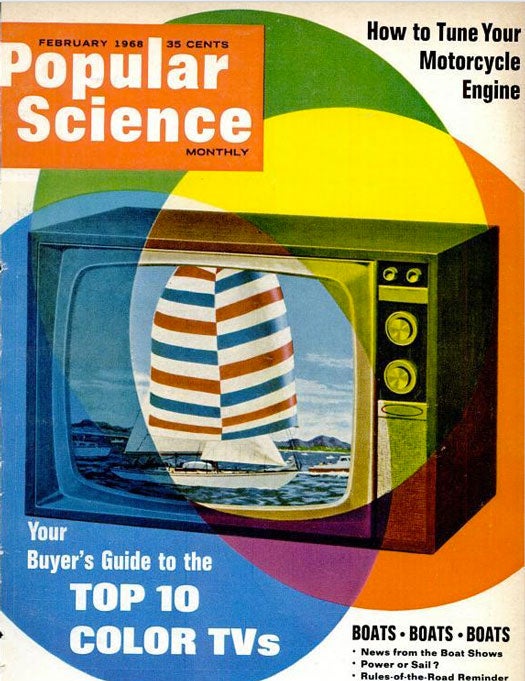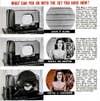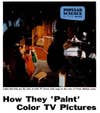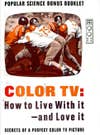In the early 1950s, we grappled with a life-changing dilemma: to buy a color TV set, or not to buy a color TV set? In retrospect, the right answer seems obvious, but the hassle of switching systems in those days meant that viewing black and white images was more tolerable than shelling out the money needed to make the transition.
A brief history lesson for those of you unacquainted with that era: in October 1950, following years of squabbling between various corporations, the FCC finally authorized CBS’ system of color broadcasts as the national standard. Despite their successful campaign, CBS ran into a number of problems once they actually starting implementing their technology. Firstly, 10.5 million black and white TV sets had been purchased nationwide, and none of them could receive color programs. Since viewership was limited, advertisers were hesitant to sponsor programs that practically no one would see. The venture was doomed.
Click to launch the photo gallery.
In spite of the system’s technical difficulties, we recognized that the color television was the future, and that we would be remiss in not hailing its potential. But could we in good conscience recommend purchasing color TV sets before the technology had time to mature? Color TV sets were expensive in the 1950s. In 1954, Westinghouse unveiled a set that cost just under $1300. Around eight years later, RCA manufactured a line that cost $500. This seemed like an awful lot of spending, especially if you’d already purchased a black and white set. But regardless of whether they could afford a color TV set, readers needed to know what they could expect from the technology once it replaced its predecessor.
Like our editors do today, we prepared our readers for the transition by testing out a few of these new-fangled color TV sets for ourselves. In 1962, our writer purchased the $500 RCA set, only to complain that setting it up was a little confusing. “The patient serviceman tried to explain to my wife what he was doing,” he said. “But she fled to the kitchen.”
All technical issues aside, seeing a program in color made the experience of watching television far more engaging than our writer could have imagined. “The sense of participation in color shows is heightened,” he wrote. “We become more absorbed in the stories; the dividing line between make-believe and the real thing is not so sharp.”
Sounds like the future to us — after all, nothing foreshadows a new era in technology like a budding addiction to your latest form of home entertainment.
Click through our gallery to read more about how we covered the introduction of color TV.
Electronic Color Television: February 1947
Up until the 1940s, color television relied on a mechanical scanning system that used three monochrome colors to produce a color broadcast or transmission. John Logie Baird, who had previously demonstrated a system that juxtaposing a black-and-white display with a rotating colored filter, started working on a superior, fully electronic system around 1940. After Baird’s premature death later that decade, other companies developed systems similar to Baird’s “Telechrome” technology. RCA engineers achieved the one on the left. Unlike mechanical systems, which used a rotating disk to transmit three colors at one time, this system split a single beam of light into red, blue, and green images. Three kinescopes containing the cathode ray, projection, and tubes would simultaneously pick up and project the merged color picture onto the screen. Read the full story in Electronic Color Television is Here
CBS Color Broadcasting: December 1950
After years of competition amongst various corporations, the FCC finally announced CBS’ color television technology as the national standard in October 1950. In June of 1951, CBS began broadcasting color television programs on five East Coast stations. While campaigning for FCC authorization, CBS aired a series of successful test programs, but things went downhill once they actually got what they wanted. There were 10.5 million black and white sets in the United States by that time, and very few color sets, so viewership was extremely limited. Advertisers were hesitant to air commercials that hardly anyone would see, and to make things worse, manufacturers failed to produce adapters that would permit black and white sets to receive programs in color. This feature, published just two months after the FCC’s announcement (and a year before CBS’ system was discontinued) presented our readers with some alternatives to replacing their old black and whites. Even then, we knew the transition was likely destined for failure. “Despite the FCC’s ‘final’ decision in favor of CBS color, many TV manufacturers are continuing their fight against it,” we said. “They have started legal action that may delay the timetable set for color. It’ll probably take a ruling from the U.S. Supreme Court to put a stop to the wrangling once and for all.” Read the full story in Here’s Your Color TV
A Glossary of Color TV Terms: July 1954
Color television production returned in 1953 after a brief hiatus. This time, the transition was more successful. The National Production Agency lifted its ban on manufacturing color TV sets and the National Television System Committee (NTSC) received authorization for its system at the end of the year. In January 1954, NBC aired the first nationwide color broadcast and in March of that year, Westinghouse began selling color TVs for just under $1300. We welcomed the new era of entertainment with a glossary of terms readers would have to learn once color TV sets became the standard. “A” was for additive, “B” was for back porch, “C” was for chroma control, “D” was for decoder, “E” was for electron gun, and so forth. Read the full story in ABC’s of Color Television
Putting the Color in Color TV: October 1954
The introduction of color TV not only revolutionized home entertainment, but it unlocked television’s potential as an art form. We spent this article explaining how Rod Davis, Operations Supervisor for Color TV at NBC, used lights and colors to manipulate the mood of a scene. While the crew for black and white pictures relied on shadows to create an atmosphere, color television “painters” could swathe a villain in red light or enhance a romantic scene by adding a sunset. Color could also make images look more three-dimensional. For instance, pouring pale blue light between sidewalks would make a street look wider, while an orangey hue at the end of a road would lengthen its appearance. Read the full story in How They ‘Paint’ Color TV Pictures
How Color TV Works: October 1956
By 1956, color television sets were well on their way to become a standard household item. But why had the process taken so long? Using images from a Popular Science educational film strip, we explained that a color TV receiver has to do thrice the amount of work as its black and white counterpart. While the old TV sets merely adjusted light and darkness to create a picture, color TV receivers had to use red, green, and blue light to form a clear image. Read the full story in How Color Television Works
Is Color TV Worth the Money?: February 1962
By 1962, the price of an RCA color TV set had decreased to $500, so writer Charles Tepfer took advantage of the price cut by purchasing one and reviewing it for our magazine. While he enjoyed seeing programs in color, the hassle of setting up his new toy diminished the novelty of the experience. First off, the technology was a little intimidating. “The patient serviceman tried to explain to my wife what he was doing–but she fled to the kitchen,” Tepfer wrote. Tepfer also found that the contrast control on a color TV set was less effective than it was on a black and white; the black and white picture’s resolution was blurrier on a color TV set than on the black and white set; and that color is best on live shows, decent on taped shows, and inconsistent on filmed shows. Also, it became pretty obvious after a few hours of viewing that some shows just weren’t designed for color sets. For instance, one variety program featured dancing wearing just black and white costumes. Despite the set’s technical issues, Tepfer found TV shows far more engaging when they were in color than when they were in black and white. “We become more absorbed in the stories,” he said. “The dividing line between make-believe and the real thing is not so sharp.” Read the full story in Color TV: Is It Worth the Money?
How to Love Color TV: December 1965
Nowadays, there’s nothing complicated about buying a new TV. You lay down the money, lug the package home, plug in the set, and commence watching. Earlier color TV sets required a little more fiddling, though, so ease the process for our readers, we published this straightforward guide to making the most of a color TV set. “Be fussy!” we said. “Some people are happy watching a color TV picture that looks like a wet page from the Sunday comics color section. We’re betting you aren’t one of them….” To ensure a good experience with their TV, we encouraged readers to watch a full show in color before letting the serviceman leave. That way, flaws in the set could be corrected before they got too annoying. Once the TV was set up, every family member had to learn the proper way to tune in a color picture and adjust the dials. Finally, you had to learn proper care for your set, which meant maintaining the antenna, replacing bad tubes, and optimizing control settings. Read the full story in Color TV: How to Live With It — and Love It
Color TV is Officially Worth the Money: August 1963
A year after Charles Tepfer reviewed RCA’s $500 color TV set for us, writer C.P. Gilmore tried out the technology for himself, and reported back with favorable results. In the past couple of years, the number of color TV sets nationwide rose to more than a million, while companies other than RCA began manufacturing their own color lines. Meanwhile, established stations like NBC, ABC and CBS were releasing more and more color programs. The more prevalent color TV became, the more the quality of its images improved. Despite his initial skepticism, Gilmore found that watching shows in color felt so natural that viewing programs in black and white felt a little jarring. Live programs were “stunning,” and a first-year service contract cost $10 more for color than for black and white — a perfectly reasonable price considering how much enjoyment you would get from the experience. Consumers had to be careful with a couple of things after buying their TV though. Mounting it on a swivel base could result in a blotchy screen, as color tubes were prone to becoming magnetized after too much movement. People also had to know what they were paying for. Just because a set was more expensive didn’t mean it would transmit a better picture. Chances are, the extra costs would come from remote controls, better speakers, or fancier cabinetwork. Read the full story in Color TV: Is It Finally Worth the Money?
Color TV Around the World: March 1967
Canada and Europe were quick to adapt color TV broadcasts following their success in the United States, albeit with slightly altered technology. While Canada and Japan continued using the NTSC system developed in the United States, Monaco and the USSR used the French SECAM system, while Great Britain used West Germany’s PAL technology. The reason these countries decided to forgo NTSC technology was that implementing it over long distances would be too expensive and troublesome to maintain. Instead of splurging for pricey imported equipment, SECAM and PAL countries developed color TV systems more resistant to signal distortion than NTSC broadcasts. Thanks to this innovation, those using SECAM and PAL receivers could enjoy color TV programs without having to manually adjust the tint. Read the full story in Around the World With Color TV
Top 10 Color TVs: February 1968
Less than a decade before this article was written, only one company manufactured color TV sets. By 1968, the market was so varied that most TV rookies didn’t know where to begin. To narrow down their favorite sets, a panel of six PopSci editors evaluated 11 color TVs for picture quality and ease of use. Remote controls and aesthetic design didn’t matter. All we wanted to know was which TVs you could enjoy the most for the least amount of work. Our tests concluded that the Magnavox had the most lifelike colors, the Zenith had the best resolution, the Sylvania had the brightest screen, and the Motorola had the most consistent tonal range. All 11 sets required a little tinkering with the knob to achieve the perfect balance of color. Overall, the Magnavox scored best thanks to its superior color sensibility, black and white picture quality, tonal range, and careful workmanship. Read the full story in Your Buyer’s Guide to the Top 10 Color TVs










